英语ⅰ译林牛津版unit1第四课时教案
- 格式:doc
- 大小:78.00 KB
- 文档页数:19
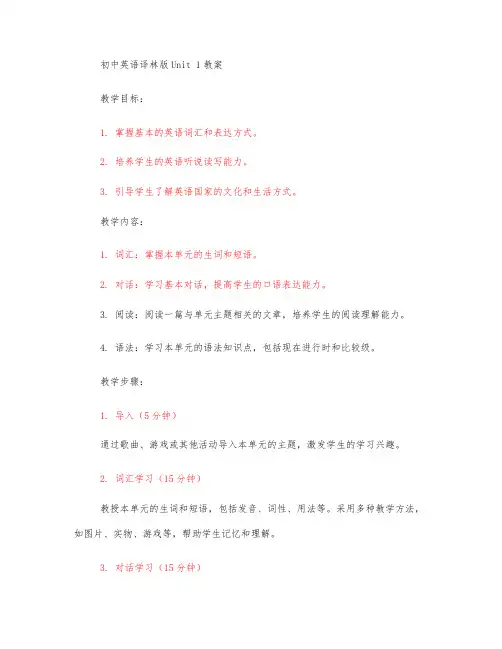
初中英语译林版Unit 1教案教学目标:1. 掌握基本的英语词汇和表达方式。
2. 培养学生的英语听说读写能力。
3. 引导学生了解英语国家的文化和生活方式。
教学内容:1. 词汇:掌握本单元的生词和短语。
2. 对话:学习基本对话,提高学生的口语表达能力。
3. 阅读:阅读一篇与单元主题相关的文章,培养学生的阅读理解能力。
4. 语法:学习本单元的语法知识点,包括现在进行时和比较级。
教学步骤:1. 导入(5分钟)通过歌曲、游戏或其他活动导入本单元的主题,激发学生的学习兴趣。
2. 词汇学习(15分钟)教授本单元的生词和短语,包括发音、词性、用法等。
采用多种教学方法,如图片、实物、游戏等,帮助学生记忆和理解。
3. 对话学习(15分钟)学习基本对话,包括问候、介绍、询问等日常用语。
通过角色扮演、小组讨论等方式,让学生在实际情境中运用所学对话。
4. 阅读理解(15分钟)阅读一篇与单元主题相关的文章,引导学生理解文章大意,回答相关问题。
培养学生的阅读理解能力和阅读速度。
5. 语法讲解(15分钟)讲解本单元的语法知识点,包括现在进行时和比较级。
通过例句和练习题,帮助学生理解和掌握语法规则。
6. 练习与巩固(10分钟)通过练习题、听力、口语等方式,巩固所学词汇、对话和语法知识。
及时纠正学生的错误,提高学生的学习效果。
7. 课堂小结(5分钟)对本节课所学内容进行总结,强调重点和难点。
布置课后作业,要求学生复习所学内容,预习下一单元内容。
教学评价:1. 通过课堂表现、作业完成情况、考试成绩等方式评价学生的学习效果。
2. 及时反馈学生的学习情况,鼓励学生积极参与课堂活动,提高学习自信心。
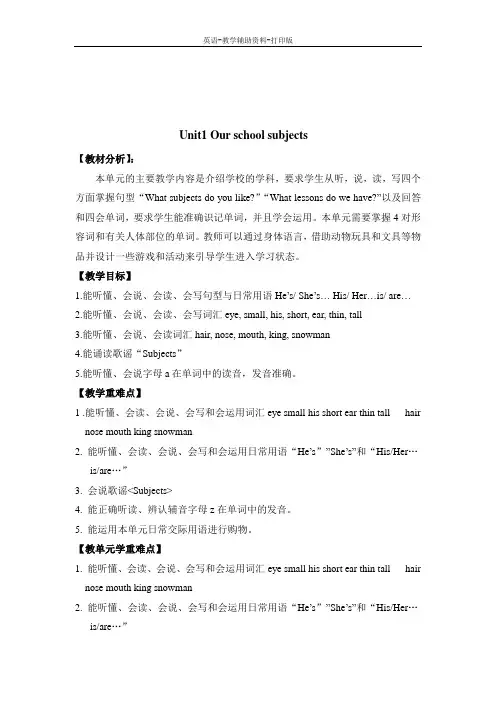
Unit1 Our school subjects【教材分析】:本单元的主要教学内容是介绍学校的学科,要求学生从听,说,读,写四个方面掌握句型“What subjects do you like?”“What lessons do we have?”以及回答和四会单词,要求学生能准确识记单词,并且学会运用。
本单元需要掌握4对形容词和有关人体部位的单词。
教师可以通过身体语言,借助动物玩具和文具等物品并设计一些游戏和活动来引导学生进入学习状态。
【教学目标】1.能听懂、会说、会读、会写句型与日常用语He’s/ She’s… His/ Her…is/ are…2.能听懂、会说、会读、会写词汇eye, small, his, short, ear, thin, tall3.能听懂、会说、会读词汇hair, nose, mouth, king, snowman4.能诵读歌谣“Subjects”5.能听懂、会说字母a在单词中的读音,发音准确。
【教学重难点】1 .能听懂、会读、会说、会写和会运用词汇eye small his short ear thin tall hair nose mouth king snowman2. 能听懂、会读、会说、会写和会运用日常用语“He’s””She’s”和“His/Her…is/are…”3. 会说歌谣<Subjects>4. 能正确听读、辨认辅音字母z在单词中的发音。
5. 能运用本单元日常交际用语进行购物。
【教单元学重难点】1. 能听懂、会读、会说、会写和会运用词汇eye small his short ear thin tall hair nose mouth king snowman2. 能听懂、会读、会说、会写和会运用日常用语“He’s””She’s”和“His/Her…is/are…”3. 能运用本单元日常交际用语进行购物。
【教具准备】:1.多媒体课件2.录音机、磁带3.图片、实物、头饰【课时划分】Period 1 Story timePeriod 2 Fun time & Cartoon timePeriod 3 Sound time Ticking time &Rhyme timePeriod 4,Checkout timeUnit1 Our school subjects第一课时【教学内容】Unit1 Our school subjects(Story time)【教学目标】1.能初步听懂、会说、会读单词:timetable,PE,Science,fun,playground2.能初步听懂、会说、会读、会写单词:school,subject,see, Chinese,Maths,Art, Music3.能初步听懂、会说、会读句型:Welcome back to school.;Nice to see you.;What subjects do you like?以及回答I like…;【教学重点】:1.能初步听懂、会说、会读单词:timetable,PE,Science,fun,playground2.能初步听懂、会说、会读、会写单词:school,subject,see, Chinese,Maths,Art, Music3.能初步听懂、会说、会读句型:Welcome back to school.;Nice to see you.;What subjects do you like?以及回答I like…;【教学难点】:1.能初步听懂、会说、会读单词:timetable, Science,playground2.能初步听懂、会说、会读、会写单词:subject, Chinese,Maths,Art, Music4.能初步听懂、会说、会读句型:What subjects do you like?以及回答I like…;【教具准备】:挂图,卡片,PPT.【教学过程】:Enjoy a rhyme:Let’s learn(学生二年级学过这首小诗,通过课前欣赏,激起学生记忆里的知识:We learn Maths, one, two, three.We learn English, Aa, Bb, Cc.We learn Music , Do, re, mi.We learn Art, draw you and me.)Step 1 Greeting and free talk1.GreetingT:Good morning, boys and girls.S:Good morning, Miss Zhang.T:How are you?S:I’m fine, well,good…T:Nice to see you.出示句子:Nice to see you.提示学生回答:Nice to see you too.渗透本课的教学目标32.Free talkT:Where are you now?S: We are/I’m at school.(出示We are/I’m at…,提示学生用at)出示学校图片:our schoolT:We’re at school. This is our school.读词组:our schoolT:Do you like our school?S:Yes, I do./No, I don’t.T:Welcome back to school.出示句子:Welcome back to school.语音渗透:ba g chi ck en back(Welcome to的句型学生在三年级中Welcome to Toy Museum中接触过了,因此难度有所降低)T:We are learning English now.出示单词:English,并且教读What subject is it?It’s English.出示subject,并且教读T:Today we’ll takl about our subjects.出示课题:Unit 1 Our school subjec tsStep 2 Presentation1.Watch and answer这一部分教学内容:单词新授:timetable,English, Chinese, Maths, Art, PE, Music, science句型新授:What subjects…?出示课文插图T:This is Miss Li. Here’s a timetable.出示单词,并且板书:timetable 课程表,时间表time+table+=timetableTimetableEnglishMS黑板出示翻板What subjects do they have?They have English…看动画,寻找问题的答案在黑板上的翻板上翻,并且学习新单词例如:T:Can you find them out?学生翻单词板A: ArtT:What subjetc is it?S:It’s Art.出示单词Art.car bar market park /a:/T:What subjects do they have?S:They have English and Art.T:Good. Who can try now? What subject is it? P:PES:It’s PE.T:What subjects do they have?S:They have English, Art and PE.同法教授单词:ChineseScienceMaths ma ngoMusic Toy Mu seum总结:T: Can you read them?拼读单词:English, Chinese, Maths, Art, PE, Music, scienceT:They are all subjects.What subjects do they have?S:They have…2.Listen and choose教授内容:单词新授:fun句型新授:What subjetcs do you like? I like…What subjects do I like?You like…What about me?You like… It’s…听录音,完成问题的回答提示内容T:Can you answer the question now?学生回答问题,并且全班读句子,加深对新知的印象教读新词:fun 乐趣,快乐un under uncle fun3.Read and answerT:What about Mike.What subjetcs does he like?What subject is it now?出示learning tip:Underline the sentences.你是怎么知道的?请把线索用直线划出来。
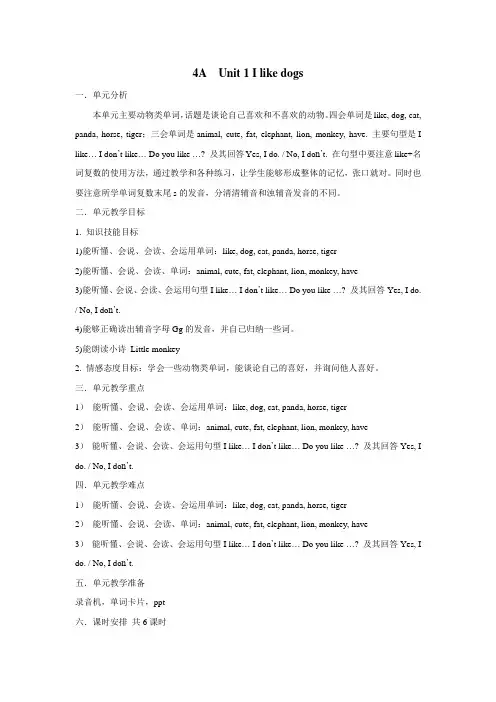
4A Unit 1 I like dogs一.单元分析本单元主要动物类单词,话题是谈论自己喜欢和不喜欢的动物。
四会单词是like, dog, cat, panda, horse, tiger;三会单词是animal, cute, fat, elephant, lion, monkey, have. 主要句型是I like… I don’t like… Do you like …? 及其回答Yes, I do. / No, I do n’t. 在句型中要注意like+名词复数的使用方法,通过教学和各种练习,让学生能够形成整体的记忆,张口就对。
同时也要注意所学单词复数末尾s的发音,分清清辅音和浊辅音发音的不同。
二.单元教学目标1. 知识技能目标1)能听懂、会说、会读、会运用单词:like, dog, cat, panda, horse, tiger2)能听懂、会说、会读、单词:animal, cute, fat, elephant, lion, monkey, have3)能听懂、会说、会读、会运用句型I like… I don’t like… Do you like …? 及其回答Yes, I do. / No, I do n’t.4)能够正确读出辅音字母Gg的发音,并自己归纳一些词。
5)能朗读小诗Little monkey2. 情感态度目标:学会一些动物类单词,能谈论自己的喜好,并询问他人喜好。
三.单元教学重点1)能听懂、会说、会读、会运用单词:like, dog, cat, panda, horse, tiger2)能听懂、会说、会读、单词:animal, cute, fat, elephant, lion, monkey, have3)能听懂、会说、会读、会运用句型I like… I don’t like… Do you like …? 及其回答Yes, I do. / No, I do n’t.四.单元教学难点1)能听懂、会说、会读、会运用单词:like, dog, cat, panda, horse, tiger2)能听懂、会说、会读、单词:animal, cute, fat, elephant, lion, monkey, have3)能听懂、会说、会读、会运用句型I like… I don’t like… Do you like …? 及其回答Yes, I do. / No, I do n’t.五.单元教学准备录音机,单词卡片,ppt六.课时安排共6课时第一课时:Story time第二课时:Fun time第三课时:Cartoon time第四课时:Sound time & Rhyme time第五课时:单元测试第六课时:试卷分析第一课时一.教学内容:Story time二.教学目标:1. 掌握四会单词及词组:chicken, duck, cow, cat, dog, panda, cute, fat, this/that…, these/those…2. 掌握四会句型: I like… .Do you like…? 及回答Yes, I do. No, I don’t. Look at … . It’s … .3. 情感目标:Animals are our good friends.三. 教学重点:1. 掌握四会单词及词组:chicken, duck, cow, cat, dog, panda, cute, fat, this/that…, these/those…2. 掌握四会句型: I like… .Do you like…? 及回答Yes, I do. No, I don’t. Look at … . It’s … .四. 教学难点:1. 单词panda, cute, fat的发音及运用2. 掌握句型: I like… .Do you like…? 及回答Yes, I do. No, I don’t. Look at … . It’s … .3. like的用法五.教学准备:PPT,单词卡片六.教学过程:Step1. Revision1. Greetings: Good m orning… Glad to see you again…2. Free talk:(1) T: Let’s enjoy a song(2) T: Do you still remember my name?What’s your name? Glad to see you again. …Step2. Presentation1. T: Yesterday, I gave you some nice pictures. And today I have some nice pictures too. Let me show them.(1) Teach: What’s this/that? It’s a dog/cat/panda.(2) T: What are they? They are animals.[领读animals 特别注意发音](3) 情感教育:Animals are our good friends.2. show some other pictures:What are these/those? [引出复数]I like …s. Do you like…s? Yes, I do./ No, I don’t.[用chant巩固Do you like …s? 并让学生自编chant]3. Teach: cute & fat [利用图片对比Look at this … . It’s … .]4. Story time : Listen and choose[让学生听并选择,训练学生的听力能力]Step3. Consolidation1. Ss read part A after the tape2. Ss try to read by themselves3. Ss try to read in roles.Step4. HomeworkRead the story板书设计:教学反思:本节课是新学期的第一节课,学生的注意力都比较集中。

Unit 1 第1课时【上好课】2021-2022学年八年级英语上册同步备课系列(牛津译林版)一、单项选择1.Among the four seas off the coast of China, East China Sea is the second ______.A.deep B.deeper C.deepest【答案】C【详解】句意:在沿着中国的四个海中,东海是第二深的。
考查最高级。
deep深的,原级;deeper更深的,比较级;deepest最深的,最高级;空前有the second修饰,当形容词最高级与序数词连用时,表示“第几最……”,故选C。
2.—Do you know the ______of the stone?—Yes. It ______ about 200 kilos.A.weight; weighs B.weight; weights C.weigh; weighs D.weigh; weights【答案】A【详解】句意:—你知道这块石头的重量吗?—是的。
它重约200公斤。
考查动词和名词。
weight“重量”,不可数名词;weigh“重量为……”,动词。
第一个空,前面有定冠词the修饰,并且在句中作主语,因此应用名词weight;第二个空,在句中作谓语,因此应用动词weigh,主语it是第三人称单数,句子时态为一般现在时,所以谓语动词也要用第三人称单数形式weighs;故选A。
3.—Yang Lin, I know you didn't tell me the ______. How could you lie(撒谎) to me?—Sorry, Mom.I won't do it again.A.plan B.place C.story D.truth【答案】D【详解】句意:—杨林,我知道你没有告诉我真相。
你怎么能对我撒谎?—对不起,妈妈。
我不会再这样做了。
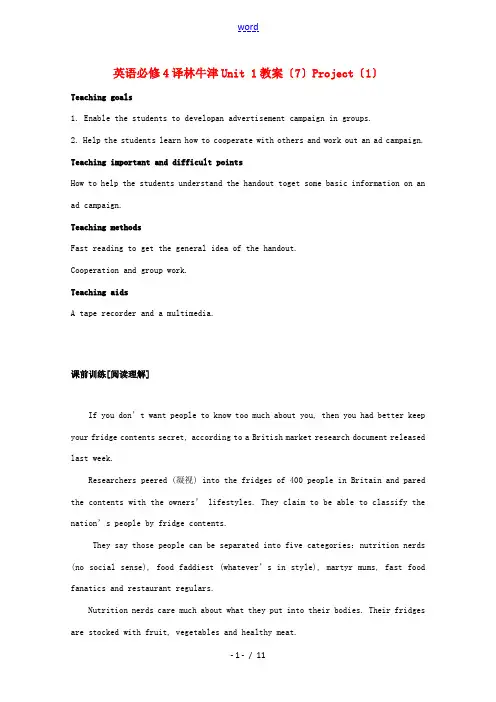
英语必修4译林牛津Unit 1教案〔7〕Project〔1〕Teaching goals1. Enable the students to developan advertisement campaign in groups.2. Help the students learn how to cooperate with others and work out an ad campaign. Teaching important and difficult pointsHow to help the students understand the handout toget some basic information on an ad campaign.Teaching methodsFast reading to get the general idea of the handout.Cooperation and group work.Teaching aidsA tape recorder and a multimedia.课前训练[阅读理解]If you d on’t want people to know too much about you, then you had better keep your fridge contents secret, according to a British market research document released last week.Researchers peered (凝视) into the fridges of 400 people in Britain and pared the contents with the owners’ lifestyles. They claim to be able to classify the nation’s people by fridge contents.They say those people can be separated into five categories:nutrition nerds (no social sense), food faddiest (whatever’s in style), martyr mums, fast fo od fanatics and restaurant regulars.Nutrition nerds care much about what they put into their bodies. Their fridges are stocked with fruit, vegetables and healthy meat.People in this category tend to be highly organized and usually work in law or accountancy. The vast majority is single, but if they have a partner, that person will be similar.A fridge full of vitamins — enriched juices implies its owner works in media or fashion. They tend not to eat the foods they buy. Known as the food faddiest, they just want to be seen as purchasing the latest important things.A fridge filled with everything from steak to frozen fish suggests the martyr mum. Her fridge tends to be stocked with every kind of product, except what she herself would want. This fridge hints at difficulty balancing family and work life.Fast food fanatics always buy mineral water or soda pop. The nearest they will get to fresh fruit is tomato sauce. Their fridges hint at someone who works hard and plays hard, also, someone who is not into long term planning.Finally, a fridge filled with nothing more than a bottle of white wine and some sparkling mineral water implies an owner who is single, lives in a big city and enjoys the finer things in life. The fridge is empty because this person regularly eats in restaurants.36. What can we know from the first two paragraphs?A. Some researchers are fond of staring at other people’s fridges.B. People don’t want others to know about their secrets.C. The food you put in the fridge has something to do with your personality.D. There are mainly five kinds of lifestyles among British people.[答案]C[解析]细节理解题。
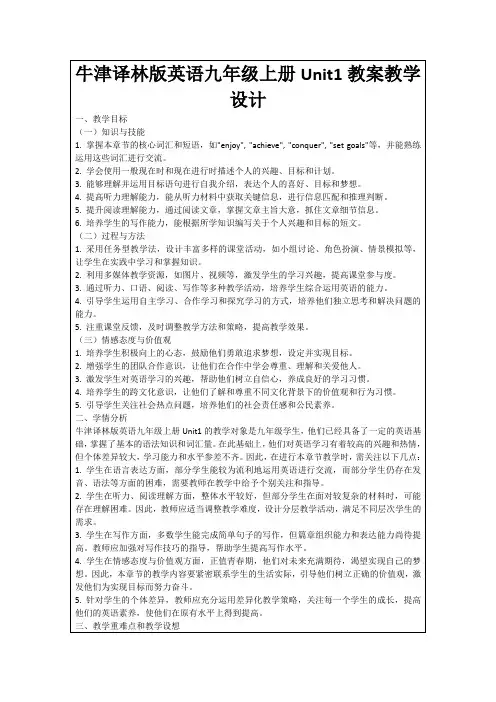
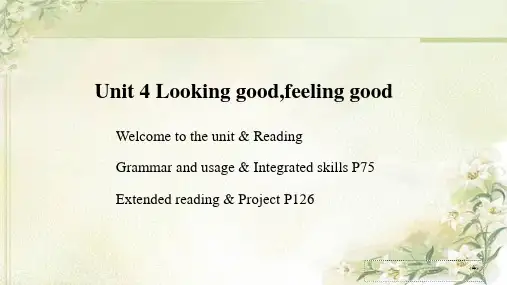
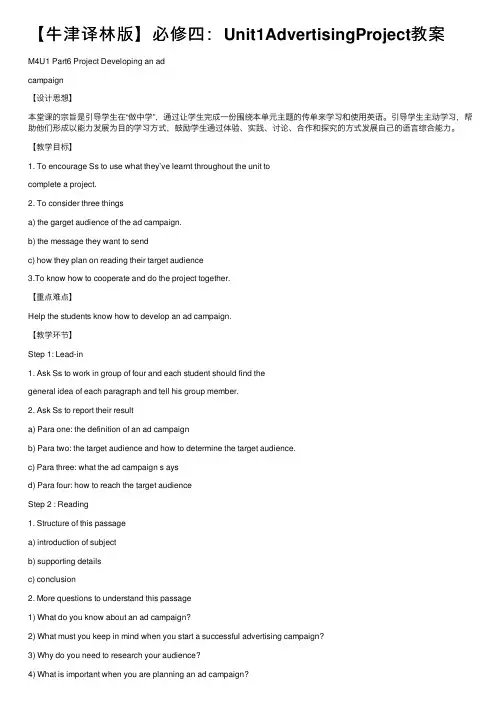
【⽜津译林版】必修四:Unit1AdvertisingProject教案M4U1 Part6 Project Developing an adcampaign【设计思想】本堂课的宗旨是引导学⽣在“做中学”,通过让学⽣完成⼀份围绕本单元主题的传单来学习和使⽤英语。
引导学⽣主动学习,帮助他们形成以能⼒发展为⽬的学习⽅式,⿎励学⽣通过体验、实践、讨论、合作和探究的⽅式发展⾃⼰的语⾔综合能⼒。
【教学⽬标】1. To encourage Ss to use what they’ve learnt throughout the unit tocomplete a project.2. To consider three thingsa) the garget audience of the ad campaign.b) the message they want to sendc) how they plan on reading their target audience3.To know how to cooperate and do the project together.【重点难点】Help the students know how to develop an ad campaign.【教学环节】Step 1: Lead-in1. Ask Ss to work in group of four and each student should find thegeneral idea of each paragraph and tell his group member.2. Ask Ss to report their resulta) Para one: the definition of an ad campaignb) Para two: the target audience and how to determine the target audience.c) Para three: what the ad campaign s aysd) Para four: how to reach the target audienceStep 2 : Reading1. Structure of this passagea) introduction of subjectb) supporting detailsc) conclusion2. More questions to understand this passage1) What do you know about an ad campaign?2) What must you keep in mind when you start a successful advertising campaign?3) Why do you need to research your audience?4) What is important when you are planning an ad campaign?5) What should your advertising campaign be based on?3. Use the same way to read the other article. Following questions will help you to understand it bette r.1)Why is anti-smo king chosen as the subject of the ad campaign?2)What is the main aim of the anti-smoking campaign?3)How can high-school teenagers be convinced not to start smoking? Step 3: Language focus:Step 4:Developing an ad campaignPlanningPreparingProducingPresentingStep 5:Homework语⾔点(供参考,可根据学⽣情况进⾏删减)1. build—built---buil t①建⽴,创⽴: build a nation 建⽴⼀个国家built a successful business out of their corner grocery store. 从他们街道拐⾓的杂货店创办了⼀家成功的公司②监督:命令、资助或监督…的建设:The administration built several new housing projects.⾏政部门资助了好⼏幢新楼的建筑项⽬We are building socialism with the Chinese characters.2. reach①被看到/听到Through television and radio we are able to reach a wider audience.②伸展,伸出,延伸:reached out an arm.伸出⼀只⼿臂③到达 I hope this little will reach you.3.have …. in mind考虑When you’re going to do sth. you must have a clear target in mind. Watching TV all evening wasn’t exactly what I had in mind.have it in mind to do sth… 打算做某事You must have it in mind to post the letter for me.keep /bear … in mind 记住= learn by heartmake up one’s mind/change one’s mind 下定决⼼/改变主意4. figure out①理解,弄明⽩I can’t figure out why he quit his job.②想出,计算出 Have you figure out how much the holiday will cost?He's trying to figure out a way to solve the problem.5. get … to do 使…做某事He got his sister to help with his homework.get … doing 使…开始做某事Can you really get the old car running again?What he said got me th inking.get … done 使…被做I got my pocket picked the other day.get done 表被动get hurt/burnt/separated6. determine v.确定;决定Vt.确定 determine sth.They have determined the date for our party.Vi.决定determine to do sth.= be determined to do sth. 下定决⼼做He determined to get there first.= He was determined to get there first.determine on (doing )sth. 就……做出决定We determined on an early start.adj. determined 有决⼼的,决定的(在句中常作定语或状语)She is a very determined woman who always gets what she wants.be determined +从句/be determined to do sth.At the age of twenty, Steve left his hometown, determined not to return without making his mark. 在⼆⼗岁时,Steve离开了他的家乡,下定决⼼不搞出点名堂绝不回来。
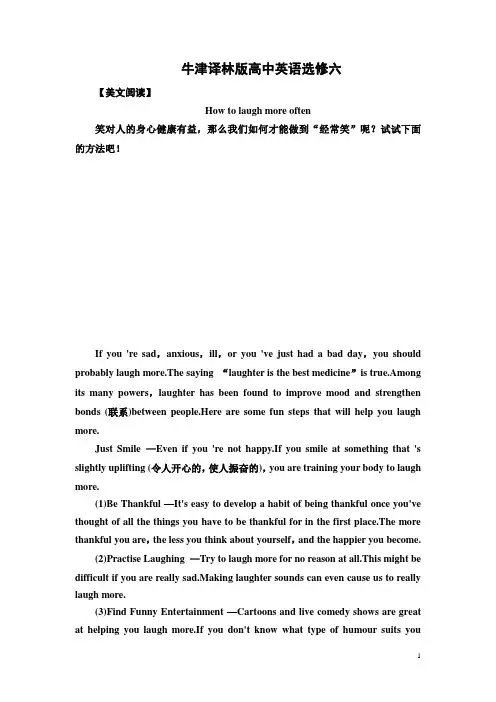
牛津译林版高中英语选修六【美文阅读】How to laugh more often笑对人的身心健康有益,那么我们如何才能做到“经常笑”呢?试试下面的方法吧!If you 're sad,anxious,ill,or you 've just had a bad day,you should probably laugh more.The saying “laughter is the best medicine”is true.Among its many powers,laughter has been found to improve mood and strengthen bonds (联系)between people.Here are some fun steps that will help you laugh more.Just Smile —Even if you 're not happy.If you smile at something that 's slightly uplifting (令人开心的,使人振奋的),you are training your body to laugh more.(1)Be Thankful —It's easy to develop a habit of being thankful once you've thought of all the things you have to be thankful for in the first place.The more thankful you are,the less you think about yourself,and the happier you become.(2)Practise Laughing —Try to laugh more for no reason at all.This might be difficult if you are really sad.Making laughter sounds can even cause us to really laugh more.(3)Find Funny Entertainment —Cartoons and live comedy shows are great at helping you laugh more.If you don't know what type of humour suits youbest,try watching all types of comedy and sooner or later you will be laughing.(4)Surround Yourself with Funny People —Even if you don't feel like leaving the house,force yourself tospend more time with people who laugh a lot.Just being around them will cause you to laugh more.(5)Be Playful —If you've ever seen a lot of children playing,you've probably heard them laugh more than most adults you know.This is because they haven't taken control of their inner playfulness.(6)Invite Laughter —Encourage your loved ones to laugh more by talking about funny things that happen in their lives.Maybe they haven't laughed enough today either.Exchange funny stories until tears pour out.【诱思导学】1.List 6 ways that the writer has given to you to train your body to laugh more.2.Which advice do you think the most helpful to make you laugh more ?Give your reasons.【答案】 1.(1)Be Thankful(2)Practise Laughing(3)Find Funny Entertainment(4)Surround Yourself with Funny People(5)Be Playful(6)Invite Laughter2.I think “Find Funny Entertainment”is the most helpful to me,because when I watch some cartoons,I can 't help laughing all the time.(The answer varies )Period ⅠPreviewing(教师用书独具)●教学目标本课时主要是通过学生对学案所给出的内容的学习,了解本课文中所出现的词汇,初步了解课文以及相关的背景知识,为下一堂课对课文的全面理解起铺垫作用。
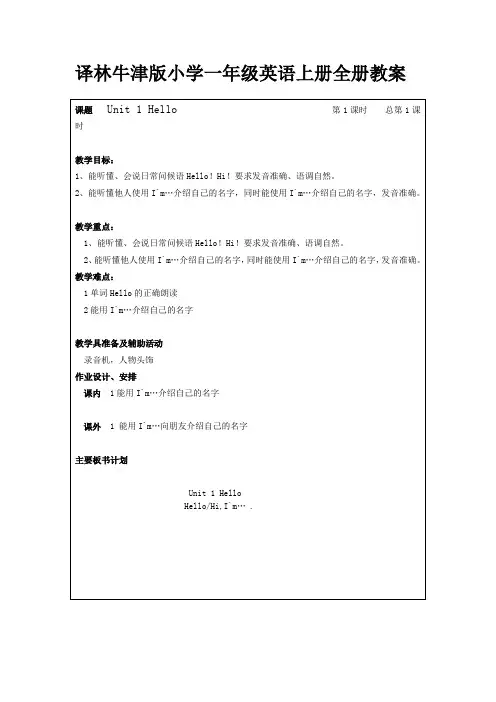
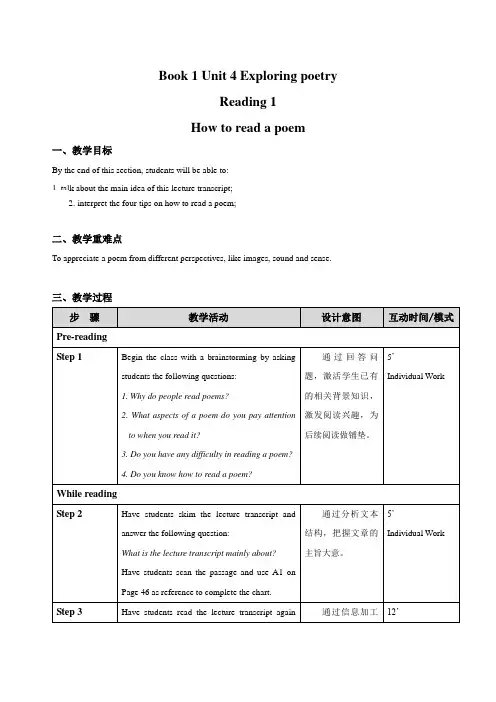
Book 1 Unit 4 Exploring poetryReading 1How to read a poem一、教学目标By the end of this section, students will be able to:1. talk about the main idea of this lecture transcript;2. interpret the four tips on how to read a poem;二、教学重难点To appreciate a poem from different perspectives, like images, sound and sense.三、教学过程步骤教学活动设计意图互动时间/模式Pre-readingStep 1 Begin the class with a brainstorming by askingstudents the following questions:1. Why do people read poems?2. What aspects of a poem do you pay attentionto when you read it?3. Do you have any difficulty in reading a poem?4. Do you know how to read a poem?通过回答问题,激活学生已有的相关背景知识,激发阅读兴趣,为后续阅读做铺垫。
5’Individual WorkWhile readingStep 2 Have students skim the lecture transcript andanswer the following question:What is the lecture transcript mainly about?Have students scan the passage and use A1 onPage 46 as reference to complete the chart.通过分析文本结构,把握文章的主旨大意。
《英语》(选择性必修·第一册)Unit 1 Food mattersIntegrated skills (II)I. Learning objectivesBy the end of the lesson, students will be able to:1. talk about their favorite food, including its appearance, smell, taste, ways of cooking and a particular experience associated with it;2. write an article about their favorite food.II. Key competence focusWrite an article about their favorite food.III. Predicted area of difficulty1. How to convey the ideas clearly.2. How to write an article vividly.IV. Teaching proceduresStep 1 Lead-in1.T presents some pictures of food such as mooncake, Tiramisu, dumpling, hot pot, etc. and asks the following questions:Picture 1 (Mooncake)T: What can you see in the picture?S: Mooncakes.T: Have you tried a mooncake?S: Yes.T: When did you try it for the first time?S: I gave it my first try at the age of 5.T: Do you like it?S: Yes, very much.T: How does it taste?S: It tastes sweet.Picture 2 (Tiramisu)T: Do you know the dessert in the picture?S: It is Tiramisu.T: How does it look?S: It looks adorable.Picture 3 (Dumpling)T: What’s the picture about?S: Dumplings.T: Do you know how to cook the dish?S: It can be steamed, boiled or fried.Picture 4 (Hot pot)T: What’s it?S: It’s a hot pot.T: How do you think it feels in your mouth?S: I think it is spicy.2. T asks more questions as follows:T: What’s your favorite food? Why do you like it?(Ss may give various answers.)3. T shows a picture of salted duck and mentions her experience of tasting it for the first time.T: Salted duck is one of my personal favorites. I gave it my first try twenty years ago, together with my family members. My father went on a business trip to Nanjing and brought one back. Itlooked mouth-watering. Before my mother sliced it, brother and I couldn’t wait to have a try. The meat was juicy and salty, which really impressed all of us. How can I forget such a tasty dish?【设计意图:通过互动,引入主题,并为对话环节做铺垫。
译林版普通高中教科书英语选择性必修第一册Unit 1 Food mattersReading (I) : fort food(1)单元概述:本单元的主题语境是“人与社会”,话题是“饮食文化”,涉及的语篇类型有视频、杂志文章、博客文章、食谱等。
本单元的学习旨在帮助学生认识饮食文化在跨文化交际中的重要性,并引导学生学会通过饮食了解不同地域或国家的文化。
(2)内容分析【What】本板块的语篇是一篇美食杂志文章,文体为说明文,话题是“治愈系食物”;文章主要介绍了治愈系食物的定义、特点、功效;作者重点分析了治愈系食物背后的情感和文化属性:来源于家庭的情感属性和以民族认同感为核心的文化属性。
【Why】本文旨在引导学生认识食物不仅能使人保持健康和充满活力,而且还能调节情绪、抚慰心灵。
正如文章中所介绍的,治愈系食物能让我们回忆起美好的童年,能让海外游子一解乡愁。
学习本文可以让学生学会透过现象看本质,理解饮食背后的情感因素和文化因素。
【How】本文主旨清晰,结构分明。
作者从叙述自身体验引出治愈系食物的定义,接着介绍了其中一类治愈系食物的两大特征,最后点题:治愈系食物是可口的美味,又是联结个人幸福记忆的纽带。
本文采取的第一人称视角有助于拉进与读者的距离,增加文章的真实性和说服力。
此外,本文在写作手法上还有以下几个方面的特点:细节描写形象生动;分析深入透彻、鞭辟入里;语言上使用了较多的短语动词和复合句。
作者把细腻的情感融合进朴实的文字里,说理抒情,娓娓道来,这样的写作手法值得学习和模仿。
2.学情分析What students have known:本节课授课对象为高二学生。
首先,学生在经过必修一、二、三册的学习后,对高中英语教材有了一定的了解,基本了解如何寻找主题句进而概括出中心思想,这样学生可以快速判断文章结构特征。
其次,根据英语新课程标准的要求,他们已经基本具备在阅读中通过阅读策略,如skimming、scanning、prediction、reasoning等获取细节信息的能力,部分学生能用英语自信地表达观点。
《英语》(选择性必修·第一册)Unit 1 Food mattersExtended readingI. Learning objectivesBy the end of the period, students will be able to:1. get the main information about the three traditional Chinese foods;2. write a summary of each of the three traditional Chinese foods;3. appreciate some nice words and understand their meanings and functions;4. find out the author’s views about these traditional Chinese foods and show their own opinions;5. introduce a popular dish in their hometown.II. Key competence focus1. Get the main information about the three traditional Chinese foods.2. Find out the author’s views about these traditional Chinese foods and give some opinions.III. Predicted areas of difficulty1. Write a summary of each of the three traditional Chinese foods.2. Appreciate some nice words and understand their meanings and functions.3. Introduce a popular dish in the hometown.IV. Teaching proceduresStep 1 Lead-inFree talkAfter greeting Ss, T has a free talk with them: eating is of great importance in our daily life. What food do you usually have for lunch and dinner? Then T asks Ss a question: what’s your favorite food and can you introduce something about it?【设计意图:通过自由交谈导入本节课,让学生畅所欲言讲讲自己最喜欢的食物并简单介绍,激活学生已有知识并激发学生的阅读兴趣。
《英语》(选择性必修·第一册)Unit 1 Food mattersIntegrated skills (I)I. L earning objectivesBy the end of the lesson, students will be able to:1. understand how to introduce your favourite food;2. know some basic information and some events at the school Food Festival through listening;3. predict what type of word will be filled in the blanks before listening.II. Key competence focus1. Use listening strategies to get the right information.2. Get some useful information to prepare for writing by reading and listening.III. Predicted area of difficulty1. Complete the notes while listening.2. Know about the ways to introduce the favourite food.IV. Teaching proceduresStep 1 Free talkT asks Ss to have a free talk about their favourite food.T: Hello, boys and girls. What is your favourite food? Can you introduce something about it?T: Thanks for your sharing. I think you really love the food, so maybe you will be interested in the Food Festival. There is an announcement about the school Food Festival.【设计意图:本节课以情境导入——邀请学生谈谈自己最喜爱的食物,并引出学校即将举办美食节的活动,进而引出下文的听力部分。
Unit 1 School lifeTeaching aims of the whole unit:1.Develop students’ ability of reading comprehension by reading an article about school life in the UK and two other articles about school clubs.2.Develop students’ ability of listening comprehension by listening to two talks about school activities.3.Develop students’ speaking ability by discussing daily school life and reporting school activities.4.Develop students’ writing ability by writing a notice about school activities.5.Develop students’ integrated skills of using English by making a poster for a school club.6.Enlarge students’ vocabulary about school facilities.7 Help students understand what an attributive clause is and what relative words function as in attributive clauses; teach students how to use relative pronouns that, which, who, whom and whose.Period arrangement:The whole unit: 12 periodsWelcome to the unit: 1 periodReading: 2 periodsWord power: 1 periodGrammar and usage: 2 periodsTask: 2 periodsProject: 2 periodsSelf-assessment: 1 periodRevision and exercises: 1 periodPeriod 1 Welcome to the unitI. Teaching aims:1 Get students to know the different high school loves between the UK and China.2 Develop students’ English speaking skills.II. Teaching Procedures:Step 1. Warming upLet some students make a self-introduction.1. Introduce themselves.2. Say something about their junior high school life.3. Pair work: brain storm:When we are talking about our school life, what will we probably think of?What words or phrases will we use to describe our school life? Step 2 Presentation1.Say the following to students:It’s the beginni ng of the new term. You’ve just finished your junior high and are about to enter a new period in your studies. I am happy to give your lessons and I hope we can be friends.I can see that some of your are eager to know what studying at senior high will be like. Will it be differ4ent from junior high? Well, there are certainly many differences between junior high and senior high, but there are also some things that are the same in every school in China. What about schools in other countries? Do you have different experiences? Are schools all over the world the same? This is the subject of our first unit.2. Ask students to read the instruction and tell them:Here are three pictures that show some aspects of school life in the UK. Please read the instructions, look at the pictures: what's the difference between schools in China and the UK?Step 3 Discussion1 Ask students the following questions to talk about the words in the four pictures:Huge campus and low-rise buildingsWhat does huge mean?What does low-rise mean?What about campus and school buildings in China?(Schools in China usually have a large enough campus to make sure students have enough space to study and play. But most school buildings have at least 3 storeys.)Lockers for every studentDo you know what a locker is?(There are rows of lockers by the classrooms for students to put their bookd, exercise-books and other belongings.)What do you think about locker for students?Do you think that we should have such locker in our school? Why or Why not?Fewer students in each classHow many students are there in our class?Do you know the number of students in a class in the UK?At ease with our teacherWhat can we know from this picture?What does the word ease mean? What do you think the phrase at ease mean?Were you getting on well with the teacher when you were in junior high?What relationship do you want to have with your teachers in senior high?2 Ask students to work in groups to talk about the four pictures and the differences between schools in the UK and China. Then ask several students to report their discussion to the whole class.aspects In the UK In ChinaHuge campus and low-rise buildings We can see hugecampus andlow-rise buildings.It is the biggestdifference fromschools in ChinaSchools in China usually have alarge enough campus to make surestudents have enough space tostudy and play in.But most school buildings aretaller, at least three storeys.Lockers for every student There are rows oflockers by theclassrooms forstudents to put theirstationary, books,exercise-books andother belongings.Students bring what they need forlessons to school and then take itall back home after school. Mostschools in china do not haveequipment in the classroom.Fewer students in each class There are fewerstudents in a class,no more than 30 perThere are usually more students inhigh school, perhaps 40 to 50 perclass. Recently some schools areclass. beginning to limit the number ofstudents in each class.At ease with our teacher Students have aclose relationshipwith their teachers.They feel at easeand comfortablewith them.It is similar in china. Nowadays,lots of teachers and students haveestablished a good relationshipwith each other. They respect eachother and work to gain a betterunderstanding of each other.3. Ask students to discuss the three questions in pairs, and them ask some of them to report their answers to the questions to the whole class.What is your dream school life like?What kind of school activities do you enjoy?What do you think of your life here in the new school?Step 4 Summary and HomeworkToday we’ve mainly talked about the differences between the high school lives in the UK and in China. After class you should:1) Recall all the new words and expressions that we learn in this lesson.2) Find more about any other differences between the high school lives in the UK and in China, either by surf the Internet or by reading some articles in newspapers or magazines.3) Preview the following part: reading (page 2 to page 4).Period 2 Reading (1) School life in the UKTeaching aims:1. Get students to know what school life is like in a high school in the UK.2. Develop students’ ability of reading comprehension through:1)skimming and scanning.2)Guessing the meanings of some new words from the context3. To learn some expressions about school life.Teaching procedures:Step 1 Lead-in and PresentationSay the following to the students:Yesterday we’ve talked about the differences between the high school lives in the UK and in China. We know well about the high school lives in China, because we are Chinese. But we know a little about the high school lives in the UK. Yeah? Today we are going to read a magazine article which is written by an exchanging student. She has been studying in the UK for one year. Now she gives a clear brief introduction about her school life there.(Bb: School life in the UK) Before we read the article, we are going to learn the reading strategy: skimming and scanning.Please look at page 3: Reading strategy. (Bb the following while learning the reading strategy. )Skimming: to get a general idea of the article, without studying it in detail.Focus on the titles, headings, the first and last sentences or paragraphs, charts and pictures …scanning: to find certain information in an article quickly.Look for key words and phrases, dates and numbers, etc.Step 2. Reading1. Skimming:Question: How does Wei Hua feel about her life in the UK?2. Scanning:1)Ask students to go through the three questions in part A and makesure that each of them know the meaning of each question.(AWoodwork class is a class in which students make somethingfrom wood.)Ask students to read the passage as quickly as possible and try to find answers to the three questions. Remind students only tofocus on and identify the most important information.2)Ask student to reread the passage and complete Part C1individually. Then ask some of them to give the answers to thequestions in Part C13)Ask students to finish Part C2 individually. Then get somestudents to share their answers with the whole class. Ask them to say the true sentences to correct the false ones.3 GuessingAsk students to finish Part D individually. Tell them not to look up the meanings of the words from the wordlists in the textbook. Let themguess the meanings from the context. Then check the answers with the whole class.Step 3 New Words in this UnitStudy the new words appears from page2 to page 5 (from attend to immediately) at page 68.Step 4. Homework.1. Complete part E on page 5.2. Read the two articles in reading on pages 82 and 83 in wb and answers the questions below them.3. Learn all the new words we learned today by heart.Period 3 Reading (2) School life in the UKTeaching aims:1 Help students become more familiar with the article.2 Develop students’ ability of reading comprehension by finding out what topics are covered in the article.3 Develop students’ ability of speaking by discussing the subjects they like in school.Teaching Procedures:Step 1. Revision:Check the homework:1)Have a dictation to go over the words learned last period.2)Check the answers in reading on pages 82 and 83 in wb.3)Ask some students to read the article in Part E to check whetherthey have used the suitable word in each blank.Step 2 Reading1) Ask some students to read the article aloud paragraph by paragraph. Ask other students to find out what topics are covered in it.School hoursSchool assemblyTeachersClass sizeDifferent classes in different classroomsHomeworkSubjects and favourite subjectsWhat to do at lunchtimeBritish food3)Ask students to point out the different high school lives in the UKand in China in these topics.Step 3 DiscussionLet students look at Part F together and discuss the questions in Part F in Pairs. Then get some pairs to act out their discussion in class.Step 4 Language focus1 Ask students to find out the following words, phrases and sentences in the article. Then give some explanations.Words:a)as (since, because, for)b)attend (join, join in, take part in)c)prepared)experiencee)respectf)exciting, excitedg)dropPhrases:a)for freeb)be happy withc)used to do sth.; be/get used to do sth.; be/get used to doing sth.d)the way to do; the way of doing; the way + Attributive Clausee)at the end of; in the end; by the end off)as … asSentences:a)Going to a British school for one year has been a very enjoyableand exciting experience for me.b)I do like eating.c)We also had different students in some class, so it was difficult toremember all the faces and names.2 Ask students to put the following sentences into English in their exercise-books.1) Jim 加入了我们的讨论之列。
英语必修4译林牛津Unit 1精品教案(背景信息)U1 第三部分教案Background information(牛津译林版必修4)●Section 2 Background informationI. An introduction to Advertising1. Definition:American Marketing Association (AMA) defines advertising as “the non-personal communication of information usually paid for and usually persuasive in nature about products, services or ideas by identified sponsors through the various media.” Today, with the development of the technology and the diversity of the mass media, advertising has influenced us pervasively in our daily life. However, whatever the promotive strategies advertising takes, language is the main carrier of message all along, as The Language of Advertising, by Vesterg ard & Schroder, says, “Advertising takes many forms, but in most of the m language is of crucial importance.” Advertising language is a style of immediate impact and rapid persuasion. The point of an advertisement is to persuade you of the merits of a particular product or service, in order that you will take out some of your money.2. Advertising Components: According to the definition of the advertising, most of the advertisements should have the following components:(1) AdvertiserThe advertiser is the sender of information and all the advertising activities should be consistent with the purpose and willingness of the advertiser. Therefore, the advertiser is the main body of advertising, namely, every advertisement should have its specific owner of the advertising information. The specific owner should be a recognizable group, including corporation, enterprise, government, organization and individual. There are three significances of an advertiser (both for the advertiser themselves, and for the public): firstly, it’s easy for the target audience to recognize the company and the products of it, which will promote the propagandas andthe sale of its products; secondly, it will establish a high reputation for the group, enterpr ise, or the individual in order that the consumer will trust the brand; finally, it will prevent the advertiser from counterfeiting and deceiving by legal supervision.(2) A certain amount of money paidThe advertising fees a re paid by the advertiser no matter it’s operated by itself or other agency. Because advertising is a kind of marketing action, an advertiser has to pay for its advertisement. There are quite a few people who consider that too much advertising fee will inevitably raise the price and cost of the product, and thereby will influence the sale of the product. However, this conclusion is a one-sided view. Advertising can bring you a huge profit by reasonable planning a nd proper operation.(3) Advertising InformationAdvertising information is the principal content s an advertisement wants to disseminate. Advertising is a serious of planning action, so the information of adve rtising should be aimed at the certain target market and consumers, and should avoid aimlessness. The dissemination of information should be accurate, definite, recognizable and moderate in length. An effe ctive advertisement involves not only “what to say”, but also ‘how to say”.(4) Advertising MediaMedia are the means of the dissemination of advertising, including newspaper, magazine, broadcast, TV program, billboard and mail. The newspaper, magazine, broadcast and TV are called the four main media of advertising. Moreover, any kind of objects or tools can be a medium for the advertisement, such as airplane, train, bus, building, neon light, movie, package, exhibition, and etc. Different kinds of media have different features, disseminating area, target audience and speed.II.经典英文广告麦斯威尔咖啡 Good to the last drop 滴滴香浓,意犹未尽。
英语ⅰ译林牛津版unit1第四课时教案TeachingcontentReportingschoolactivities(1)Teachinggoals1.TargetlanguageUnderstandingaprogram:date,day,time,venue,event/activit y2.AbilitygoalsEnablethestudentstounderstandaprogram.3.LearningabilitygoalsHelpthestudentslearnhowtocompleteatimetableforaschoolpr ogram.Teachingimportant&difficultpointsHowtocompleteatimetableforaschoolprogram. TeachingmethodsListening.TeachingaidsArecorderandablackboard.TeachingproceduresStepⅠRevisionandLead-inCheckthehomeworkandreviewtheusageofrelativepronouns.T:Inthelastperiodwelearnedtheusageofrelativepronouns.Arelativepronounisawordusedtoreplaceanounornounphraseandintro ducesarelativeclausereferringtosomeantecedent.Therelativepr onounsofEnglishare:who,whom,whose,which,andthat.Nowpleasefi nishthefollowingexercises.Showthefollowing.1.Don'ttalkaboutsuchthingsof__youarenotsure.A.whichB.whatC.asD.those2.Thewolveshidthemselvesintheplaces___couldn'tbefound.A.thatB.whereC.inwhichD.inthat3.Thefreezingpointisthetemperature__waterchangesintoice .A.atWhichB.onthatC.inwhichD.ofwhat4.I'lltellyou__hetoldmelastweek.A.allwhichB.thatC.allthatD.which5.We'retalkingaboutthepianoandthepianist__wereintheconc ertweattendedlastnight.A.whichB.whomC.whoD.that6.Thegirl__anEnglishsonginthenextroomisTom'ssister.A.whoissingingB.issingingC.sangD.wassinging7.Those__notonlyfrombooksbutalsothroughpracticewillsucc eed.A.learnB.whoC.thatlearnsD.wholearn8.Anyone__thisopinionmayspeakout.A.thatagainstB.thatagainstC.whoisagainstD.whoareagainst9.Didn'tyouseetheman__?A.InoddedjustnowB.whomInoddedjustnowC.InoddedtohimjustnowD.Inoddedtojustnow10.Canyoulendmethenovel__theotherday?A.thatyoutalkedB.youtalkedaboutitC.whichyoutalkedwithD.youtalkedaboutSampleanswers:1-5AAACD6-10ADCDCTalkaboutschoolprogramswiththestudents.T:Apartfromstudyingfrombooks,weneedtolearnfromothersori npractice.Mostschoolsintheworldprovidestudentswithdifferent activitiesduringtheschoolperiod.Forexample,tolistentoafamou sscientist,tojoinaclub,todoresearchinalab,andsoon.Thesearea llschoolprograms.Today,we'llgoingtolearnwhataschoolprogramis.StepⅡUnderstandingaprogramActivity1:AskthestudentstoreadthefivepointsinSkillsbuil ding1onpage12.T:Aprogramisasetofplannedactivitiesortraining,whichhave aspecificpurpose.Insomeforeignschools,thereareprogramstopre ventthechildrenfromdroppingoutoftheschool;programstopromote theschoolfoodsafety,etc.NowreadthefivepointsinSkillsbuildin g1onpage12andmakesurewhataprogramusuallyincludes.Activity2:Askthestudentstowritedownthenamesofmonthsandt hesevendaysofaweekinabbreviations.T:Howmanypartsdoesaprograminclude?Whatarethey?S:Therearefiveparts.Theyaredate,day,time,venueandevento ractivity.T:Nextpleasewritedowntheshortformsofthetwelvemonthsands evendays.Sampleanswers:Jan,Feb,Mar,Apr,May,Jun,Jul;Aug,Sep,Oct,Nov,DecMon,Tue,Wed,Thu,Fri,SatActivity3:ListeningT:Afterreadingthefivepoints,we'veknownwhatweshouldnotic ewhenlisteningtosomeonetalkingaboutaprogram.Nowpleaselistentothetalkofafamousscientistandcompletethetimetableonpage12.Playtherecordingandthenchecktheanswerswiththestudents.StepⅢListeningPracticeActivity1:CompletingatimetableAskthestudentstoreadtheinstructionsandthetimetable.T:Nextwe'llhearatalkgivenbytheheadmasteraboutaschoolpro gram.First,readtheguidelinesandthetimetabletogetageneralide aaboutthetalk.Thenaskthestudentstolistentothetapeandcompletethetimeta bleontheirown.Checktheanswersasaclass.Activity2:CompletinganotesheetAskthestudentstoreadtheinstructionsonpage92andlistentoc ompletetheexercises.T:Inrecentyears,manycountrieshaveopenedtheirdoorstoChin esestudents,andthereforeagreatdealofthemhavedecidedtogoabro adtostudy.Inthepast,overseasChinesestudentsusedtostudyforab achelororahigherdegree,butnowadaysmanyseniorschoolstudentsw hohaven'tfinishedtheirstudyyetarechoosingtogoabroad,whichme ansyoungteenagersarenowjoininginwiththosemarchingtheirwayto wardsanewworldoutsideChina.Kelingisoneofthem.Nowreadtheguid elineonpage92.Thenlistentothetapeandcompletethenotesheet.Checktheanswers.Thenaskthestudentstolistentothetelephoneconversationbet weenKelingandherdadandcompletethenotes.Activity3:CompletingastoryAskthestudentstoreadthestoryandthenotesheetfirst,andthe ncompletethestory.Askthestudentstoreadthecompletedstorytochecktheanswers.StepⅣSummaryandHomeworkT:Todaywe'velearnedaveryusefulskill,thatishowtodevelopa schoolprogram.Themostimportantthingindevelopingaprogramisto makeacarefulplaninadvance.Afterclass,pleaseworkingroupsandd evelopaprogramplan.TeachingcontentTaskReportingschoolactivities(2)Teachinggoals1.TargetlanguageComparinginformation.2.AbilitygoalsEnablethestudentstomakedecisionsbycomparinginformation.3.LearningabilitygoalsHelpthestudentslearnhowtomakedecisionsbycomparinginform ation.Teachingimportant&difficultpointsCompareinformationtomakedecisions.TeachingmethodsDiscussionandtask-basedactivities.TeachingaidsAprojectorandsomeslides.TeachingproceduresStepⅠRevisionCheckthehomework.T:Schoolprogramshelpusindifferentways.Forexample,somepr ogramsmayhelpbuildourhealth,somemayenrichourschoollifeandso memayimproveourstudy,etc.Whatprogramhaveyoudeveloped?S:We'vedevelopedaprogramcalled2017OlympicsVolunteers.Th epurposeoftheprogramistohelpthepubliclearnmoreaboutanddosom evolunteerworkforthe2017Olympics,includingitsgoal,mascot,em blem,slogan,etc.T:Whatisyourplan?S:Ourplanis...(Thestudentsshowtheirplan.)T:However,youdohaveotherprogramstodo.Inordernottomissot herimportantprogramsoractivities,youneedmakeacorrectdecisio n.Thefirstthingyoudo,Ithink,istocomparetheinformationathand .It'sveryimportanttohelpmakeafightdecision.Today,we'lllearn howtomakedecisionsbycomparinginformation.StepⅡLead-inGetthestudentstoknowhowtocompareinformationbeforemaking decisions.T:Inourdallylife,weoftenhavetomakemanychoices.Thenwhowo uldliketotellmehowyoumakeadecisionwhenthereareseveralchoicesaheadofyou?S:Letmehaveatry.OftenIwouldcomparethepossiblechoicesrep eatedlyandcarefullybeforeImakeadecision.Askthestudentstoreadthetwopointsaboutcomparinginformati onbeforemakingdecisionsonpage14.T:Comparinginformationisnecessaryandimportantbeforemaki ngafightandappropriatedecision.Tomakecomparisonsistofindout thesimilaritiesandthedifferencebetweenthetwothings.Nowpleas ereadthetwopointsonthescreenabouthowtomakecomparisons.Showthefollowingonthescreen.◇readalltheinformationcarefully◇makeasmanycomparisonsaspossibleStepⅢWritingActivity1:ReadingandcomparingtheinformationAskthestuden tstoreadtheguidelinesandthelistofthesevenbooks.T:Tomakecomparisons,youshouldknowfirstwhatthepurposeis, whattocompareandhow.Nowhereisanexampleforyou.Pleasereadthee -mailDavidBrownwrotetoYangYanasfastasyoucanandfindoutwhatth emainideaofthee-mall.S:Inhise-mail,DavidBrownasksYangYantofindouttheISBNofah istorybook,partofwhichhehasreadwhenhevisitedYangYan,inhersc hoollibrary.Hecan'tremembertheexactISBNofthebookbutonlysome vagueinformationofit.Askthestudentstocomparethelistofthesevenbooksandtheinfo rmationgivenintheletter.T:Thenpleasereadthee-mailagaincarefully,andfindtheinfor mationDavidBrownhasprovidedaboutthebookandcompletethefollow ingchart.Showthefollowingonthescreen.Title:__________Author:__________Year:__________Price:__________Sampleanswers:Title:Includingtheword“Dynasties”Author:AfamousprofessorYear:After2000Price:Containingthenumber8Thenaskthestudentstocomparethelistofthesevenbookswithth einformationgiveninthelettertofindtheclues.T:Nowthatyouhaveknownsomeinformationaboutthebook,nowple asecompareittotheinformationintheformabovethee-mailanddecid eifyoucanfindoutthecorrectISBN.S:TheISBNofthebookis7-8976-9374-B/K.Activity2:WritingareplyT:You'vemadeafightdecisionbycomparingtheinformation.Now pleasewritebacktoDavidBrownforYangYan.Whenwriting,pleasepay attentiontothepatternofane-mail.Asamplee-mail:DearDavidBrown,I'mverygladtoreceiveyoure-mail.Accordingtotheinformatio nyouprovideaboutthishistorybook,Ihavefounditoutforyou.Ihave foundtherearesevenbooksinthelibraryaboutChinesehistory.Butonlyfouroftheminclude“Dynasties”inthetitle.Onthebackcoversofthem,Isawtheirpricesandtherewer ethreeofthemleft.Theninaccordancewithauthorandyear,Ifoundit outfinally.ItsISBNis7-8976-9374-8/K.Youcanorderacopyofitsoo n.Bestwishes,YangYanStepⅣSpeakingActivity1:ComparingtheinformationAskthestudentstocomparetheinformationinthetimetablewith theschoolprogramonpage13.T:Sometimesyouneedtoskipcertainclassestoattendsomeschoo lprograms.Inthiscase,youshouldmakeacorrectdecisioninorderno ttomissthemoreimportantone.Nowpleasereadtheinstructionsandt heforminPartAofStep2,compareyourclasstimetablewiththeschool programonpage13andfindoutwhatclassesyoucanskiptoattendtheta lks.S1:WecanskiptheGamesonMonday.S2:AndtheLibraryClassonTuesday.S3:TheSelf-studyonWednesday.S4:TheLibraryClassonThursday.S5:TheClassMeetingonFriday.Thenaskthestudentstochoosethefivetalksyoucanattend.Sampleanswers:1.Fireprevention2.SchoollifeintheUSA3.Outerspace4.FightingAIDS5.AustralianpopsongsActivity2:ReportingAskthestudentstoreadtheinstructionsinPartBonpage15.T:NowreadtheinstructionsinPartBfirst.Andthenworkinpairs talkingaboutthetalksaccordingtotheprogramtimetableonpage13a ndthenotesinPartA.Asampledialogue:SI:Ms...,therearealtogetherfivetalkswecanattend.Theyare Fireprevention,Outerspace,SchoollifeintheUSA,FightingAIDS,a ndAustralianpopsongs.S2:OK.Whenisthefirsttalkforourclass?SI:Itstartsat2.15p.m.till3.55onMonday,11thOct.Wecanskip theGamesclass.Thetalkwillbegivenbyafireman,tellingussomethi ngaboutthefireprevention.S2:Averyusefultalk.Youshouldlistentothetalkcarefullyand trytolearnsomethingonhowtopreventafirehappening.Bytheway,whereisthetalktobeheld?SI:ItistobeheldinRoom503,Building3.S2:Don'tforgettotakeanote.Whataboutthesecondone?SI:ThesecondoneisSchoollifeintheUSA,tobeheldinRoom404,B uilding1,at3p.m.on13thOctbyaUSstudent.S2:Thisoneisalsogreat.Youcanlearnabouttheschoollifestyl eofUSstudentsandfindoutthedifferencesbetweenourschoollifean dtheirs.Thenwhataboutthethirdone?SI:ThethirdoneisOuterspace.Itissaidthataveryfamousscien tistwillgivethetalk.AnditistobeheldinRoom105,Building2,at8p .m.on19thOct.S2:Great!Ithinkitisaveryinterestingtopicandcandrawallyo urattention,isn'tit?SI:Sureitis.Whentheotherstudentslearnsuchatopicisinclud ed,theybecomefairlyexcited.I'malsoeagerforit.S2:Thentheothertwo...?SI:Well.Thefourthone,FightingAIDS,inRoom306,Building4,a t2.30p.m.on21stOctbyadoctorandthelastone,Australianpopsongs ,inRoom303,Building4,at10p.m.on29thOctbyafamoussinger.S2:Great!Youarenotexpectedtomissthem.Remember,arriveont ime!SI:Thanks.StepⅤSummaryandHomeworkT:Bymakingcomparisons,wecanseeclearlythesimilaritiesand differencesbetweendifferentinformation.It'soneofthebestways tomakecorrectdecisions.Afterclass,youareaskedto1.Writeanarticleinwhichyoucompareyourstudymethodwiththa tofyourclassmate(s)andmakeyourdecisions.2.PreviewSkillsbuilding3andStep3.TeachingcontentTaskReportingschoolactivities(3)Teachinggoals1.TargetlanguageWritinganotice.2.AbilitygoalsEnablethestudentstowriteanotice.3.LearningabilitygoalsHelpthestudentslearnhowtowriteranotice. Teachingimportant&difficultpointsHowtowriteanotice.TeachingmethodsDiscussionandtask-basedactivities.TeachingaidsAprojectorandsomeslides.TeachingproceduresStepⅠRevisionCheckthehomework.T:Inthelastperiod,welearnedhowtomakedecisionsbycomparin parisoniseverywhere.Whenwesay,WeiHua'sEngli shisbetter,Jessica'sthebestbasketballplayerinourschool,wear emakingcomparisons.Bymakingcomparisonswithothers,wecanfindt heweaknessesnessesandstrongpointsofourselves.That'struetoth estudymethod.WhyissomeonebetteratEnglishthanyou?Whycansomeo nealwaysgetgoodmarksintheexams?Haveyouevermadecomparisonsin yourmethods?Ifso,whathaveyoudrawnfromyourcomparisons?Askthestudentstoshowtheirwork.S:Icomparedmymethodofstudyingwiththatofmydeskmate.First ,heneverstudiesforlonghours.Itseemsheisalwaysfree,butofteng etshighmarks.ButIusedtositandstudyforlongeachtime.Youknow,t ositandstudyforhoursandhoursisnotonlyboring,itcreatestiredn ess,stressanddistraction.Youcannotlearnifyouaretired,stress edanddistracted!Second,hereviewswhathelearnedintheclassimme teron,Iwillformthehabit ofreviewingwhathavelearnedassoonaspossible.Asweallknow,ifwe waitafewdaysandthenmakeeffortstoreviewthematerial,itwillsee mmuchlessfamiliar.Third,mydeskmatetoldmethatmanystudentsdonotreachtheirgoalsbecausetheysetthemtoohigh.Hesaidhisgoalist olearnsomethingneweveryday.Itseemssimple,buthegetsinthehabi tofachievingthemandsoonhemadegreatprogress.Thecomparisonsta rtledme.Ihavehadsomanybadhabits!SoIdecidedtochangemystudyme thodfromnowon.StepⅡLead-inT:Whenourschoolhassomethingtotellallthestudents,whichme ansdoyouthinkcanbeused?S:Broadcasting.S:Havingmeetingswithteachers.S:Puttingonnotices....T:Toinformothers,oneofthewaysittoputonnotices.Thendoyou knowwhatanoticeis?Howtowriteanotice?Nowreadtheguidelinesonp age16andfindout.Askthestudentstoreadthenoticegivenbytheschoollibrary.T:Nowreadthenoticefromtheschoollibrary.Pointouttheimpor tantinformationinit.Showthefollowing:Event:Time:Reason:Whentoreopen:Thenewopeninghours:Publicholidays:Whogivesthenotice:Sampleanswers:Event:libraryclosedDate:16thto18thNovDay:nextWednesday,ThursdayandFridayReason:thesportsmeetingwillbeheldWhentoreopen:Saturday(19thNov)Thenewopeninghours:Mon-Fri:8am-6pmSat&Sunday:10am-5pmPublicholidays:closedWhogivesthenotice:ZhongShengxiao Askthestudentstotalkabouthowtomakeanoticeattractive. T:Whatshouldwecandotomakeanoticeattractive?S1:Wecanwritethetitleinboldandbigletters.S2:Wecanputsomephotosorpicturesinit.S3:Wecanusedifferentcolorstomakeitclear.StepⅢWritingAskthestudentstoreadtheguidelinesinStep3onpage17.T:Nextpleasewriteanoticetoinformyourclassmatesoftheprogramyou'llattend.Nowreadtheguidelinesonpage17first.Asamplenotice:NoticeTalksinOctoberIamverygladtoinformyouthattherearefivetalkstobeheldnext month.Thetopicsofthem,respectively,areFireprevention,Outers pace,SchoollifeintheUSA,FightingAIDS,andAustralianpopsongs. Theplaces,thetimeandthespeakersofthetalksareasfollows: Fireprevention:byafireman;inRoom503,Building3;at2.15p.m .on11thOct.SchoollifeintheUSA:byaUSAstudent;inRoom404,Building1;at 3p.m.on13thOct.Outerspace:byafamousscientist;inRoom105,Building2;at8a. m.on19thOct.FightingAIDS:byadoctor;inRoom306,Building4;at2.30p.m.on 21stOct.Australianpopsongs:byafamoussinger;inRoom303,Building4; at10a.m.on29thOct.Thankyouforyourkindattention.LiMingmingStepⅣPracticeAskthestudentstowriteanote.T:Whenwegivesomeoneinformationandthepersonmaynotbeprese nt,youcanwriteanote.Thenotewillhelpthepersonremembertodosom ething.Nextpleasereadtheinstructionsonpage93andthenwriteano te.Asamplenote:DearMickey,It'sapitythatyouareoutwhenIcometovisityou.Butitdoesn'tm atter.Iinviteyoutopayavisittomeatourschool.HereIleaveyouano tewithourschoolmap.Whenyouwalkthroughtheschoolgateintotheca mpus,youcanseetwopathsonthetwosidesoftheplayground.Takethep athontheleftandyouwillpassbygym,libraryandteachers'office.S eeingabeautifulriver,youshouldcrossthebridgeoverit.Thenturn leftandwalkabout300meters,youwillreachDorm1,whereIlive.That 'sit.WangJunStepⅤHomeworkWriteanoticebasedonthefollowinginformation由于学校要进行运动会,原定于11月5日进行的期中考试将改在11月20日。